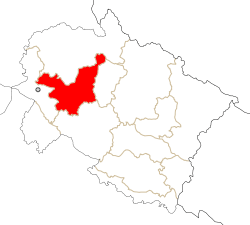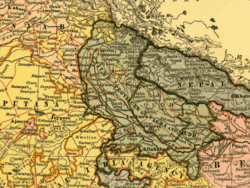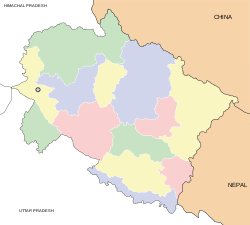Tehri Garhwal district
Tehri Garhwal is a district in the hill state of Uttarakhand, India. Its administrative headquarters is at New Tehri.[1] The district has a population of 618, 931 (2011 census), a 2.35% increase over the previous decade. It is surrounded by Rudraprayag District in the east, Dehradun District in the west, Uttarkashi District in the north, and Pauri Garhwal District in the south. Tehri Garhwal is a part of the Himalayas
Tehri Garhwal district | |
|---|---|
District | |
 Location in Uttarakhand, India | |
| Coordinates: 30.38°N 78.48°E | |
| Country | |
| State | Uttarakhand |
| Division | Garhwal |
| Headquarters | Tehri |
| Area | |
| • Total | 4,080 km2 (1,580 sq mi) |
| Population | |
| • Total | 618,931 |
| • Density | 148/km2 (380/sq mi) |
| Languages | |
| • Official | Hindi |
| • Native | Garhwali |
| Time zone | UTC+5:30 (IST) |
| Vehicle registration | UK 09 |
| Website | tehri |
Etymology
The name Tehri has been derived from Trihari, signifying a place that washes away the three types of sins – sins born out of Mansa, Vacha and Karmana or thought, word and deed, respectively. Garh in Hindi means fort.
History
Early
Prior to 888 AD, the region was divided into 52 garhs which were ruled by independent kings. These garhs were brought into one province by Kanakpal, the prince of Malwa. Kanakpal, on his visit to Badrinath, had met the then mightiest king Bhanu Pratap who later married his only daughter to the prince and handed over his kingdom to him. Kanakpal Singh and his descendants gradually conquered all the garhs and ruled the whole of Garhwal Kingdom for the next 915 years, up to 1803.
Garhwal Kingdom

Tehri Garhwal[2] or the Garhwal Kingdom, was a princely state, ruled by the Parmar (Shah) dynasty. Later, it became a part of the Punjab Hill States Agency of British India, which consists of the present day Tehri Garhwal District and most of the Uttarkashi district. In 1901, it had an area of about 4,180 square miles (10,800 km2) and a population of 268,885. The ruler was given the title of raja, but after 1913, he was honoured with the title of Maharaja. The ruler was entitled to salutes of 11 guns and had a privy purse of rupees 300,000. The princely state acceded to India on 1 August 1949.
Gorkha Rule
Gorkhas were expanding their kingdom. Gorkhas Started invading and occupying on other Kingdoms. In 1803, the Gorkhas invaded over Garhwal.[3] The Gorkha army generals Subba Amar Singh, Hastidal Chautariya, Bamshah Chautariya and Ranjor Thapa commanded a huge army in the crusade against King Pradyumna Shah and his sons Kunwar Parakrama Shah and Kunwar Pritam Shah. Garhwal Army fought with the Gorkhas at Khurhbure where the Garhwal king was killed. Gradually, the Gorkhas occupied Dehradun, Saharanpur, Kangada and Shimla and later on extended their kingdom up to Kangra.

From 1787 to 1812, the Gorkhas invaded and occupied nearly 200 villages which were under the control of the East India Company. The British argued with the king but to no avail. Finally, the Gurkha War began in 1814, when an army of 8,000 under Major General Marley attacked Kathmandu. Four thousand soldiers under Major General Wood started an operation from Gorakhpur and 3,500 soldiers attempted to take over Dehradun under Major General Zileswy. Finally, the British army captured Dehradun on 30 November 1814.
The British Army then moved towards Kumaon. After a fierce battle, the Gorkha commanders Hastidal and Jayrakha were killed at Vinayathal. The war ended with the Sugauli Treaty, signed on 2 December 1815 and ratified on 4 March 1816 by Gorkha supreme commander Bamshah and thus, British rule started in the hills. The East India Company then merged Kumaon, Dehradun and east Garhwal into the British Empire while west Garhwal was given Back to Sudarshan Shah which then became known as Tehri Riyasat.
New capital
King Sudarshan Shah established his capital at Tehri town and afterwards his successors Pratap Shah, Kirti Shah and Narendra Shah established their capital at Pratap Nagar, Kirtinagar and Narendra Nagar, respectively. Their dynasty ruled over this region from 1815 to 1949. During the Quit India Movement people of this region actively worked for the independence of the country. Ultimately, when the country was declared independent in 1947, the inhabitants of Tehri Riyasat (Tehri State) started their movement to free themselves from the clutches of the maharaja.
Due to this movement, the situation became out of his control and it was difficult for him to rule over the region. Consequently, the 60th king of Pawar Vansh, Manvendra Shah, accepted the sovereignty of the Indian government. Thus, in August 1949, Tehri Riyasat was merged into Uttar Pradesh and was given the status of a new district, the Rudraprayag district.[4] Subsequently, on 24 February 1960, the state government separated its one tehsil which was given the status of a separate district named Uttarkashi. The former royal palace of the Maharaja of Tehri Garhwal at Narendra Nagar, now houses the Ananda–In the Himalayas spa, established 2000.[5]
Economy
In 2006 the Ministry of Panchayati Raj named Tehri Garhwal one of the country's 250 most backward districts (out of a total of 640).[6] It is one of the three districts in Uttarakhand currently receiving funds from the Backward Regions Grant Fund Programme (BRGF).[6]
Crops
Dry season crops include wheat, barley, masoor, Bengal and red gram, rapeseed and mustard, and pea. Wet season crops include rice, barnyard millet, finger millet, black gram, sesame and soybean. Various fruits and spices grow in the district also.[7]
Assembly Constituencies
- Ghanshali (SC)
- Deoprayag
- Narendranagar
- Pratapnagar
- Tehri
- Dhanolti
Administrative setup
The district of Tehri Garhwal is divided into two subdivisions: Kirti Nagar and Tehri-Pratap Nagar. It has seven tehsils, one sub-tehsil, nine blocks, two municipalities and four town area committees. The district covers 76 Nagar Panchayats and 928 gram panchayats. It has 1,847 revenue villages and 2,508 clusters.
| Particulars | Number | Name |
|---|---|---|
| Subdivisions | Kirti Nagar and Tehri-Pratap Nagar and Dhanolti | |
| Tehsils | Deoprayag, Ghansali, Narendra Nagar, Pratap Nagar, Tehri, Jakhanidhar and Dhanolti and Kandisaur and Nainbaag | |
| Sub-Tehsil | Gaja | |
| Blocks | Bhilangana, Chamba, Deoprayag, Jakhanidhar, Jaunpur, Kirtinagar, Naredranagar, Pratapnagar and Thauldhar | |
| Municipalities | Tehri, Narendra Nagar, Chamba and Devprayag | |
| Town area committees | Kirtinagar and Muni Ki Reti | |
Major towns
- New Tehri, Uttarakhand
- Pratap Nagar, Uttarakhand
- Kanha
- Chamba
- Ghansali
- Chamiyala
- Kothiyara
- Deoprayag
- Kirtinagar
- Narendarnagar
- Odadhar
- Bhatwara
- Ghuttu
- Satiyala Bhilang
Villages
BLOCK (PRATAP NAGAR)
PATTI (RAIKA)'
- Bhengi
- Pariya
- Sem, Ghandylki & Gadoli
- KolDhar
- Baseli
- Kanda
- Okhla
- Raulakot
- Bair Baagi
- Nakot
- Chanthi
- Banali
- Motana
- Chaundhar
- Kotga
- Ronia & Pathiyana
- Kangsali
- Bhainga
- Jangi
- Kyarki
- Godari
- Gairi
- ब्लॉक जौनपुर(पट्टी दशजुला)
- Sinjal
- Khatt
- Bhal
- Aginda
- Marar
- Than
- Pipola
- Tipri
- Uthad
- Bhatwara
- Thela
- Tharti
- pilkhi
- Baunsla
- Banchuri
- Ghanti
- Thapla
- Dwari
- Bhonr
- Malyakot
- Pundoli
- Nail Chami
- Badiyargaon
- Hulanakhal
- Dhamatoli
- Saman Gaon
- Balma
- Baggi
- padagali
- satiyala
- Kond
- Painuyala
- Budogi
- Patta
- Kaimsari
- Gyansu
- Navagar
- Kandakholi
- khimra
- Kafald
- Sonyaat goan
Near Gajja
- Khand
- Taila
- CHandelii
- Nakot
- Ghar gaon
- Dandali
- Jakholi
- Khola
Near Chamba
- Dharsal Gaon
- sabli
- kanda
- Pali
- Fakot
- Bhona Bagi
- Jhulak (Ramgaon)
- Goldenvillage (sunar gaun)
- Chopra ( Near Kamand )
- Ramol Sari
Near Chinyali
- Ghon
Near Chamiyala
- Anuwan
- Khwala Bahedi
- ghansali
- sendula
- saransgaon
- chakursera
- gangar
- kemar
- shrikot
- shen
- sunerighad
- dewli
- badwali kumarghaw
- dung
- shenj
- kastal
- samendidhar
- Jakhani po lambguwan Dhanendra semwal (danni)
- Titrana Chond
- Bhadoli Near Bagwan
Near Ghuttu
- Satiyala
- Raitgaon
- Malla Gawana
- Rishidhar
- Kandargoan
- chadoli
- jogiyada
- devling
- Kailbagi
- Bhatgaun
Dogi Patti
- Bankatal
- Bhairgarh
- Silkani
- Bairai Gaon
- Ghigud
- Kakhoor
- Tipri
- Kyara
- Kotar
- near budhakedar( thathi kathud)
Gurukelapeer temple.
1 Binkkhal.
Maa jawalamukhi.
2 Agunda. 3 Koti. 4 Pinswad. 5 Titruna. 6 Bhishan. 7 Kot. 8 Bhigun. 9 Shonla. 10 Dalla. 11 Tingad. 12 Toli. 13 Jakhana. 14.Genwali 15.khawara 16.bhetti 17.syura 18.poni Note. There are Some areas unknown for the world located around the budakedar
- Mahasartaal (lake)
- Sehsartal lake on the peak.
- Bheemtal lake of the Indian ancient God beem pandav.
- Beauty of the peaks.
Demographics
According to the 2011 census Tehri Garhwal district has a population of 618,931,[8] roughly equal to the nation of Solomon Islands[9] or the US state of Vermont.[10] This gives it a ranking of 520th in India (out of a total of 688).[8] The district has a population density of 169 inhabitants per square kilometre (440/sq mi).[8] Its population growth rate over the decade 2001–2011 was 1.93%.[8] Tehri Garhwal has a sex ratio of 1078 females for every 1000 males,[8] and a literacy rate of 75.1%.[8]
The major first language of the district is Garhwali, accounting for 90% of the population according to the 2011 census. Hindi is widely used as a lingua franca, but is the first language of only 6% of the people. Other languages spoken include Jaunsari (1%) and Nepali (0.95%).[11]
| Tehri Garhwal district: mother-tongue of population, according to the 2011 Indian Census.[11] | |||
|---|---|---|---|
| Mother tongue code | Mother tongue | People | Percentage |
| 002007 | Bengali | 813 | 0.1% |
| 006102 | Bhojpuri | 3,427 | 0.6% |
| 006195 | Garhwali | 560,020 | 90.5% |
| 006240 | Hindi | 37,092 | 6.0% |
| 006265 | Jaunpuri/Jaunsari | 6,046 | 1.0% |
| 006340 | Kumauni | 861 | 0.1% |
| 010008 | Maithili | 401 | 0.1% |
| 014011 | Nepali | 5,876 | 0.9% |
| 016038 | Punjabi | 541 | 0.1% |
| 022015 | Urdu | 622 | 0.1% |
| – | Others | 3,232 | 0.5% |
| Total | 618,931 | 100.0% | |
Hindus number 596,769; Muslims 6,390 (1.05%); and Sikhs 561[12]
| Year | Pop. | ±% p.a. |
|---|---|---|
| 1901 | 180,788 | — |
| 1911 | 202,264 | +1.13% |
| 1921 | 214,090 | +0.57% |
| 1931 | 235,038 | +0.94% |
| 1941 | 267,178 | +1.29% |
| 1951 | 277,115 | +0.37% |
| 1961 | 313,210 | +1.23% |
| 1971 | 358,117 | +1.35% |
| 1981 | 446,472 | +2.23% |
| 1991 | 520,256 | +1.54% |
| 2001 | 604,747 | +1.52% |
| 2011 | 618,931 | +0.23% |
| source:[13] | ||
Modern developments
In the 1960s, Tehri Garhwal extended much farther east than it currently does.[14] In 1997, much of the eastern portion of Tehri Garhwal was detached and merged with portions of the Pauri Garhwal district and the Chamoli district to form the Rudraprayag district.
Notable people
- Anand Sharan Raturi, educator
- Sunderlal Bahuguna, environmentalist
- Nathi Singh Kharola, first IAS of Tehri and Uttarkashi Distt
- Pradeep Singh Kharola, Air India CMD
References
- http://tehri.nic.in/pages/display/54-location-and-area#
- Tehri Garhwal The Imperial Gazetteer of India, 1909, v. 23, p. 269.
-

- History Archived 9 August 2008 at the Wayback Machine Rudraprayag Official district.
- Himalayan Spa for Sybarites By CELIA W. DUGGER. New York Times. July 30, 2000.
- Ministry of Panchayati Raj (8 September 2009). "A Note on the Backward Regions Grant Fund Programme" (PDF). National Institute of Rural Development. Archived from the original (PDF) on 5 April 2012. Retrieved 27 September 2011.
- "Agriculture Contingency Plan for District : Tehri Garhwal" (PDF). agricoop.nic.in/. Archived from the original (PDF) on 21 March 2015. Retrieved 4 February 2016.
- "District Census 2011". Census2011.co.in. 2011. Retrieved 30 September 2011.
- US Directorate of Intelligence. "Country Comparison:Population". Retrieved 1 October 2011.
Solomon Islands 571,890 July 2011 est.
- "2010 Resident Population Data". U.S. Census Bureau. Archived from the original on 1 January 2011. Retrieved 30 September 2011.
Vermont 625,741
- C-16 Population By Mother Tongue – Uttarakhand (Report). Office of the Registrar General & Census Commissioner, India. Retrieved 14 July 2020.
- "Uttarakhand – Districts of India: Know India". National Portal of India. Retrieved 4 April 2009.
- Decadal Variation In Population Since 1901
- Times World Atlas, 1967 Edition, Plate 30.
External links
| Wikimedia Commons has media related to Tehri Garhwal district. |
